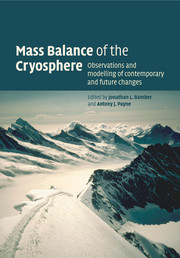Book contents
- Frontmatter
- Contents
- List of contributors
- Foreword
- Preface
- 1 Introduction and background
- Part I Observational techniques and methods
- Part II Modelling techniques and methods
- 5 Modelling land-ice surface mass balance
- 6 Modelling land-ice dynamics
- 7 Modelling the dynamic response of sea ice
- Part III The mass balance of sea ice
- Part IV The mass balance of the ice sheets
- Part V The mass balance of ice caps and glaciers
- Index
- References
6 - Modelling land-ice dynamics
Published online by Cambridge University Press: 16 October 2009
- Frontmatter
- Contents
- List of contributors
- Foreword
- Preface
- 1 Introduction and background
- Part I Observational techniques and methods
- Part II Modelling techniques and methods
- 5 Modelling land-ice surface mass balance
- 6 Modelling land-ice dynamics
- 7 Modelling the dynamic response of sea ice
- Part III The mass balance of sea ice
- Part IV The mass balance of the ice sheets
- Part V The mass balance of ice caps and glaciers
- Index
- References
Summary
Introduction
Glaciers respond dynamically to external forcings, such as climate variations, which cause ice masses to approach a new equilibrium compatible with the new environmental conditions. For example, it has been suggested that greenhouse warming may result in increased snow fall in the interior of Antarctica and increased ablation in the coastal regions of this ice sheet. Model simulations of the ice-sheet response indicate a thickening in the interior and surface lowering near the margins. Thus, the slope of the ice surface becomes steeper, resulting in greater discharge velocities to redistribute excess mass from the interior toward the margins to compensate for mass loss from ablation. Generally, the response of ice sheets to forcings may be complicated because feedback processes become operable that may amplify or mitigate the ice sheet's adjustment to forcing or because of internal instabilities that may cause rapid changes in ice volume due to changes in the dynamical flow regime. To model ice-sheet evolution adequately, it is therefore necessary to identify the important physical controls and processes affecting the flow of glaciers.
In most models, whether numerical time-evolving or analytical, simplifying assumptions are commonly made to allow a solution to be found. Such simplifications are permissible provided the essential physics are retained. A model aimed at simulating the evolution of the Greenland ice sheet over the last few glacial cycles need not explicitly calculate deformation of each individual ice crystal.
- Type
- Chapter
- Information
- Mass Balance of the CryosphereObservations and Modelling of Contemporary and Future Changes, pp. 169 - 226Publisher: Cambridge University PressPrint publication year: 2004
References
- 9
- Cited by



